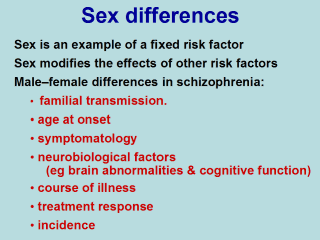| front |1 |2 |3 |4 |5 |6 |7 |8 |9 |10 |11 |12 |13 |14 |15 |16 |17 |18 |19 |20 |21 |22 |23 |24 |25 |26 |27 |28 |review |
 |
The effect of risk factors may be modified. The
developmental model can incorporate the mechanisms of possible protective
factors (eg fetal sex hormones) and/or aggravating factors (eg uterine
infections, low Vitamin D), which accelerate or delay illness progression
and raise or lower the threshold for the expression of symptoms. For example, a personís sex is an important modifier of risk factors for schizophrenia; ie, sex modifies the phenotypic expression of schizophrenia. Eg, men and women differ in age at onset, symptomatology, neurobiological factors (familial transmission, brain abnormalities and cognitive function), treatment response, course of illness and incidence. The onset of schizophrenia is later and its severity less in women, giving rise to the hypothesis that being female is a protective factor. While male-female differences may result from sexual dimorphisms in schizophrenia-determining genes, they are more likely evolve from subtle shifts in protective and aggravating risk factors. It is currently unclear whether these risk factors have a biological and/or social origin. Eg biologically, men and women differ in hormonal and immune systems, and the pace of brain maturation. One or more of these factors may be critical to the timing of onset of schizophrenia and its progression. However, there is some evidence that gendered behaviour, not only genetic sex, can influence brain morphology: so perhaps the stress buffering that results from supportive social networks (more prevalent in young women than in young men) may delay onset, promote premorbid skill acquisition, and lead to a more favourable course. Interestingly, some of these differences may not hold in developing countries where the prevalence of schizophrenia has been found not to differ between males and females. |